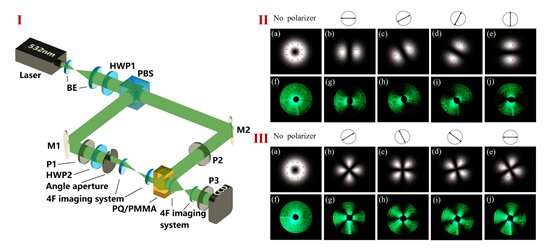Linear polarization holography

In conventional holography, the hologram is formed by recording the interference fringes of two coherent beams using a photosensitive material. The amplitude and phase information of the original signal wave can be reconstructed correctly when reading the hologram. By introducing the polarization characteristics of light into conventional holography, more degrees of freedom can be provided for controlling optical information. However, in the reconstruction of polarization holography, although the amplitude and phase of the signal wave can be reconstructed correctly, the polarization information shows rich changes. This change is not only related to the polarization states and interference angles of various types beams in the recording and reconstruction stages, but also to the properties such as polarization response, diffraction efficiency of the photoreceptor materials.
Polarized holography is still in an emerging stage. The diffraction efficiency and polarization state of reconstructed wave is mainly investigated during holographic recording and reconstruction. In recent years, polarization holography has received widespread attention with the introduction of tensor theory. By introducing the theoretical model of the dielectric tensor, this theory makes the polarization holography applicable to any interference angle and polarization state, which provides a simpler and widely applicable theoretical support for calculating the polarization state of the reconstructed wave. With the continuous deepening of theoretical research on polarization holography, it has begun to enter various application fields. It has broad development prospects in holographic data storage, light-material interaction, micro-nano structure processing and manufacturing, special optical devices, and so on.
The research team of Prof. Xiaodi Tan from Fujian Normal University is one of the earliest teams to carry out the research of polarization holography in the world. They have made a series of progress in the field of polarization holography. Based on the vector characteristics of polarized waves, they proposed the concepts of faithful reconstruction effect (FRE), orthogonal reconstruction effect (ORE) and null reconstruction effect (NRE), and analyzed the formation conditions and internal mechanism.
The review article published in Opto-Electronic Science, titled "Linear polarization holography," reviews and summarizes the development of a basic component of polarization holography (linear polarization holography) based on the achievements of research teams across the world in recent years. In the linear polarization holography, the law of the change of the polarization state and the diffraction efficiency of the reconstructed wave are mainly studied, including FRE, ORE and NRE. The article distinguishes whether the polarization characteristics of the reconstructed wave is affected by the exposure energy, and then divides it into two categories for discussion. In the reconstruction characteristics that independent of the exposure energy, the polarization characteristics of the reconstructed wave change linearly with the exposure energy, which is realized by constraining the polarization state in the process of holographic recording and reconstruction.
Combined with these reconstruction characteristics, applications such as multi-channel polarization multiplexing or vector beams generation can be realized. The experimental results verify that polarization holography can improve information storage capacity, or generate vector beams with polarization and phase vortices. Generally, the polarization characteristics of the reconstructed wave is affected by the exposure energy and present a nonlinear change. These characteristics can provide references for analyzing the polarization and diffraction efficiency characteristics of holographic gratings with micro-nano structures. In addition, it is expected to make metamaterial with anisotropic refractive index distribution through multiple exposure, to realizing the modulation of the amplitude, phase, polarization and propagation direction of light, which can allow potential applications such as optical metasurfaces, photonic crystal, all-optical logic gate, polarization sensor and so on. Consequently, it is conducive to the production of linear and nonlinear optical functional devices with low-cost planar structures, and planar optical elements with a customer-design function are possible owing to its properties. This paper aims to provide new insights and ideas, so that polarization holography can be helpful in more areas as well as be widely used.
More information: Jinyu Wang et al, Linear polarization holography, Opto-Electronic Science (2022). DOI: 10.29026/oes.2022.210009
Provided by Compuscript Ltd



















